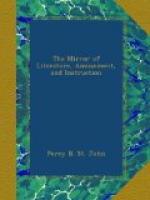in summer, but rise morning and evening only.
The blue dun has, in June and July, a yellow body;
and there is a water-fly which, in the evening, is
generally found before the moths appear, called the
red spinner. Towards the end of August, the ephemerae
appear again in the middle of the day—a
very pale, small ephemera, which is of the same colour
as that which is seen in some rivers in the beginning
of July. In September and October this kind of
fly is found with an olive body, and it becomes darker
in October and paler in November. There are two
other flies which appear in the end of September and
continue during October, if the weather be mild; a
large yellow fly, with a fleshy body, and wings like
a moth; and a small fly with four wings, with a dark
or claret coloured body, that when it falls on the
water has its wings like the great yellow fly, flat
on its back. This, or a claret bodied fly, very
similar in character, may be likewise found in March
or April, on some waters. In this river I have
often caught many large trout in April and the beginning
of May, with the blue dun, having the yellow body;
and in the upper part of the stream below St. Albans,
and between that and Watford, I have sometimes, even
as early as April, caught fish in good condition; but
the true season for the Colne is the season
of the May-fly. The same may be said of most
of the large English rivers containing large trouts,
and abounding in May-fly—such as the Test
and the Kennett, the one running by Stockbridge, the
other by Hungerford. But in the Wandle, at Carshalton
and Beddington, the May-fly is not found; and the little
blues are the constant, and, when well imitated, killing
flies on this water; to which may be joined a dark
alder-fly, and a red evening fly. In the Avon,
at Ringwood and Fordingbridge, the May-fly is likewise
a killing fly; but as this is a grayling river, the
other flies, particularly the grannam and blue and
brown, are good in spring, and the alder-fly or pale
blue later, and the blue dun in September and October,
and even November. In the streams in the mountainous
parts of Britain, the spring and autumnal flies are
by far the most killing. The Usk was formerly
a very productive trout-stream, and the fish being
well fed by the worms washed down by the winter floods,
were often in good season, cutting red, in March and
the beginning of April: and at this season the
blues and browns, particularly when the water was a
little stained after a small flood, afforded the angler
good sport. In Herefordshire and Derbyshire,
where trout and grayling are often found together,
the same periods are generally best for angling; but
in the Dove, Lathkill, and Wye, with the natural May-fly
many fish may be taken; and in old times, in peculiarly
windy days, or high and troubled water, even the artificial
May-fly, according to Cotton, was very killing.




